At what temperature does the sunshine in Spain become unbearable?
According to science, a wet-bulb temperature of 29°C means you should stop any exercise if your body is not accustomed to high heat.
Past 32°C it becomes dangerous to do any outside activity at all.
The wet-bulb test refers to a situation where air humidity is at 100% – but with highs over 29°C from June to September and humidity at 70-80% in coastal areas in Spain it’s not hard to imagine why homeowners rely on air-conditioning to survive the summer.
The question is – at what cost?
In this blogpost we’ll walk you through a new solution in Spain that’s helping thousands of homeowners use air-conditioning without worrying about the running costs.
The solution is using solar powered air-conditioning in Spain.
Read on to find out more!
free download
Want to See the Estimated Monthly Cost to Cool Your Home for 8 Hours a Day in Summer?
We’ve prepared a .pdf comparing estimated monthly electricity costs to heat 3 different sized properties using high-efficiency AC units and solar panels.
Click below and enter your email address to get the download.
How much does the electricity cost to run my AC?
To turn on the AC or not to turn on the AC?
This question runs through the mind of every homeowner in Spain from June to September, as the hottest parts are the day are typically when electricity costs are at their highest.
If you know how much electricity your air-conditioning unit/s consume (in kW) you can perform a rough calculation. (If you don’t you can skip this bit!)
kW input x hours of operation x 30 days = kWh consumption in one month.
For example: 1.5 kW input x 8 hours x 30 days = 360 kWh.
If you know the cost of electricity in your contract with your supplier you can now find a rough monthly cost.
For example: 360 kWh x 0.21 €/kWh = €75.6.
A more accurate answer depends on:
- The hours you run your air conditioning per day
- The hours you run your air-conditioning when you’re at home (e.g. weekends) and when you’re out or at work (e.g. weekdays)
- The electricity consumption of your air-conditioning unit/s
- The efficiency rating of your air-conditioning unit/s
- The cooling capacity of your air-conditioning unit/s
- The cost of electricity
- The size of the space you want to cool down
- Your home’s thermal insulation
- Your local climate, including humidity, distance to coastline, shading, breeze, temperature and more…
The above factors can make a dramatic difference to the monthly cost of using AC.
free download
Want to See the Estimated Monthly Cost to Cool Your Home for 8 Hours a Day in Summer?
We’ve prepared a .pdf comparing estimated monthly electricity costs to heat 3 different sized properties using high-efficiency AC units and solar panels.
Click below and enter your email address to get the download.
What about installing energy efficient air-conditioning?
In the European Union it is mandatory for air-conditioning units to show their energy efficiency.
Until March 2021 the ratings went from A+++ to D.
But now efficiency ratings have been simplified: they now come with letters A through to G and a corresponding colour of green through to red.
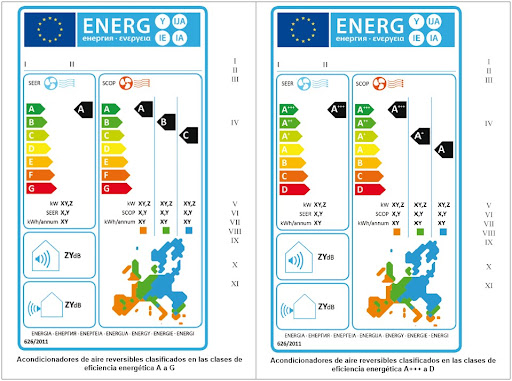
What do the energy efficiency ratings actually mean?
The efficiency of an air-conditioning unit used for cooling is determined by a rating called ‘SEER’ – it stands for the English term Seasonal Energy Efficiency Rating that was developed in the United States.
SEER ratings have been used in Spain since 2011 and are currently the European standard.
If you look at the documentation or packaging of your AC unit, you might find the SEER rating as a numeric value which is under 3.1 at the lowest efficiency and over 8.5 at the highest efficiency.
At the very highest efficiency the SEER rating can be 10 or even up to 17.
What does the SEER rating represent?
The number is a coefficient that informs how many BTU (British Thermal Units) are eliminated or extracted from the air per hour for each W (watt) of electricity consumed.
Lost?
Put simply, for the same cost of electricity an energy-efficient AC unit can provide multiple times more cooling power than a low-efficiency AC unit – sometimes up to 10x or even 17x more cooling power!
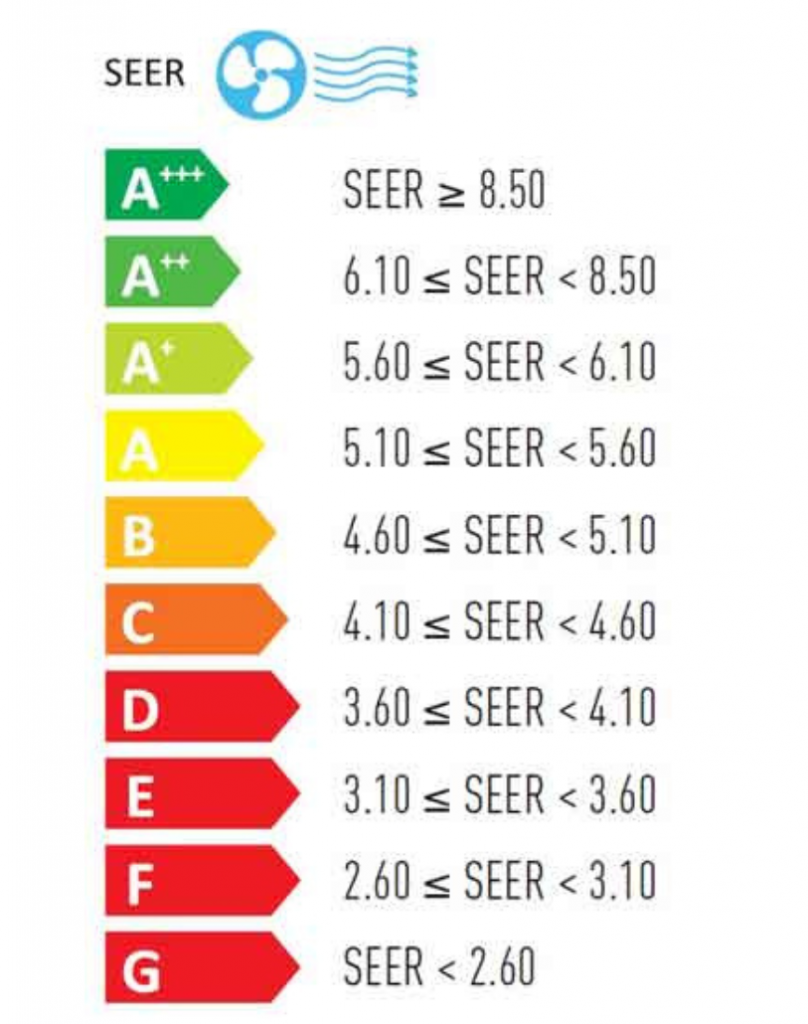
SEER ratings and their energy efficiency rating prior to March 2021.
How much cooling power do I need for effective air-conditioning in my property?
In Spain it’s common to measure the cooling capacity of air-conditioning units in frigorías.
For example, your AC unit might say on the box that it has a cooling capacity of 4,000 frigorías.
(The frigoría unit is similar to the British Thermal Unit discussed above but its calculation is based on the kilocalories an appliance uses to cool down a space and, being a metric unit rather than imperial, is more common in Europe.)
What does a frigoría mean in practice?
As a rule of thumb you need 1,000 frigorías for every 10 m2 of floor space.
In the case of an AC unit, 1,000 frigorías works out as roughly 1.163 kW of cooling capacity.
Here’s a table that shows this rough rule of thumb:
| Floor space (m2) | Frigorías | Cooling capacity |
| 30 | 3,000 | 3.49 kW |
| 40 | 4,000 | 4.65 kW |
| 50 | 5,000 | 5.82 kW |
| 60 | 6,000 | 6.98 kW |
| 70 | 7,000 | 8.14 kW |
| 80 | 8,000 | 9.30 kW |
| 90 | 9,000 | 10.47 kW |
| 100 | 10,000 | 11.63 kW |
If you know a thing or two about electric contracts in Spain you may know most apartments and houses have a contracted capacity of between 3.45 kW to 4.6 kW.
If more than the contracted capacity is consumed by appliances in the property, the power goes out.
So what if you need 11.63 kW of cooling capacity and can only consume a maximum of 4.6 kW!?
This is where high-efficiency air-conditioning units become important for day-to-day functioning during the summer (for most properties in Spain, they can’t run their AC and their washing machine at the same time).
Remember: with the highest SEER ratings of 8.1 or above this means the AC unit can provide 8.1 times more cooling capacity than they consume from the mains.
For example, a high-efficiency AC unit could produce 11.63 kW of cooling capacity while consuming around 1.4 kW of electrical power.
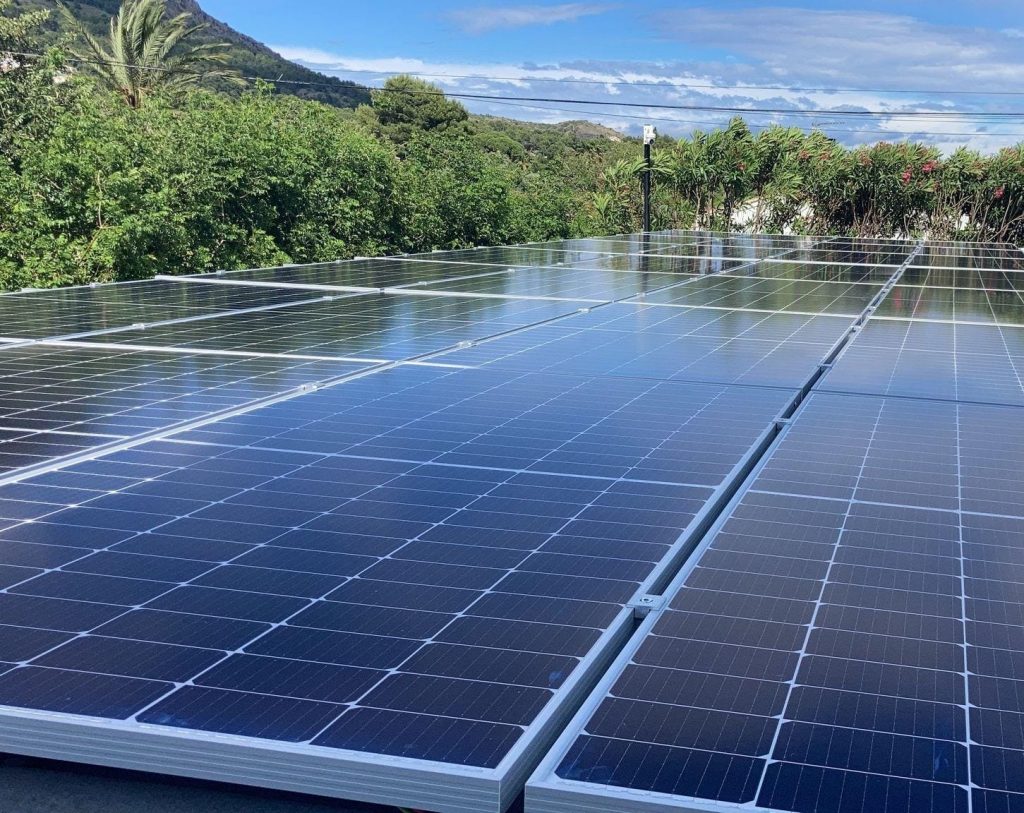
The larger the installation – like this one MiSolar completed in Javea – the more power you can supply to cool your property with solar powered air-conditioning.
Can I run air-conditioning units on solar power?
Yes, you can run air-conditioning units using solar power.
How does it actually work?
Solar panels produce direct current (DC) electricity. But when they are connected to a solar inverter, this turns DC electricity into alternating current (AC) which can power your home electrics.
During the day when power is being produced your air-conditioning unit consumes electricity generated directly by solar panels on your property instead of drawing power from the mains supply.
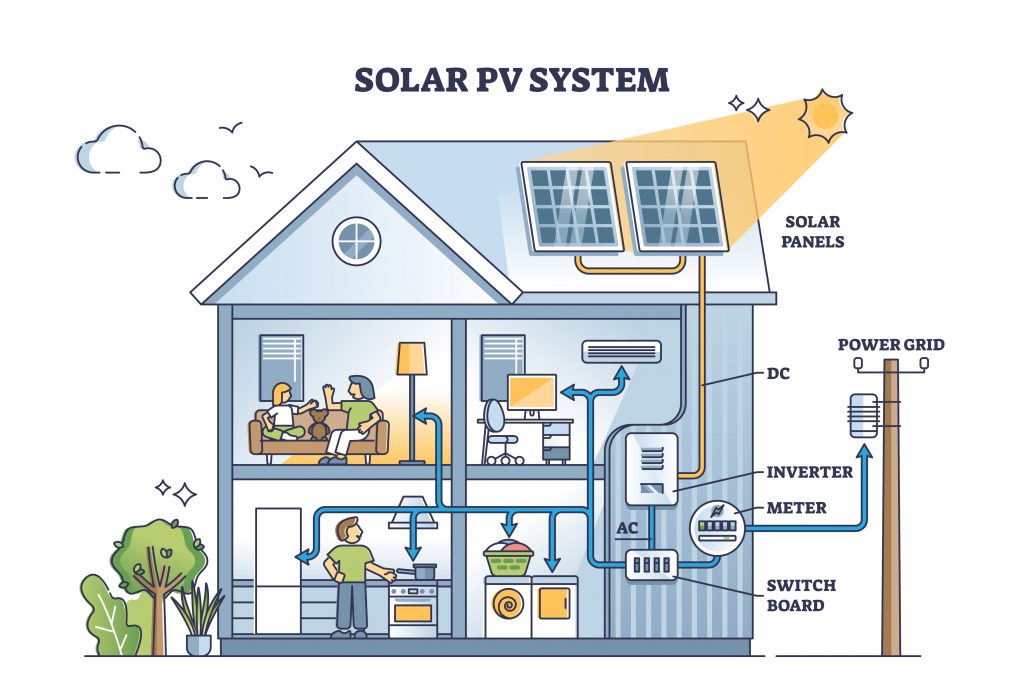
As an example, let’s say an AC unit has a cooling capacity of 3.7 kW. Let’s imagine unit is relatively low efficiency and requires an input of 1.5 kW to provide this cooling power output.
Let’s say you have three 550W solar panels that together provide a maximum of 1.65 kW of power in full sun at the correct angle. In Alicante in Spain, you can receive 5-7 peak solar hours a day in summer which allows you to fully power your air-conditioning unit from around 10am until 5pm while temperatures are at their highest.
If sized correctly, you should pay €0 to your electricity supplier while fully running your air-conditioning units during the day.
Many homeowners in Spain do not fully understand that using solar power for air-conditioning can be as simple as installing solar panels and continuing to use your air-conditioning units as normal – most likely you start using your air-conditioning more than ever before.
That said, this may not be the most cost-effective solution.
For example if a client is installing air-conditioning for the first time (or wants to maximise their cost savings) we suggest they install high-efficiency AC units alongside a solar panel installation.
This is because conventional AC units can experience power surges that consume far more power than solar panels can provide on their own, and this can drain a solar battery or require extra consumption from the mains.
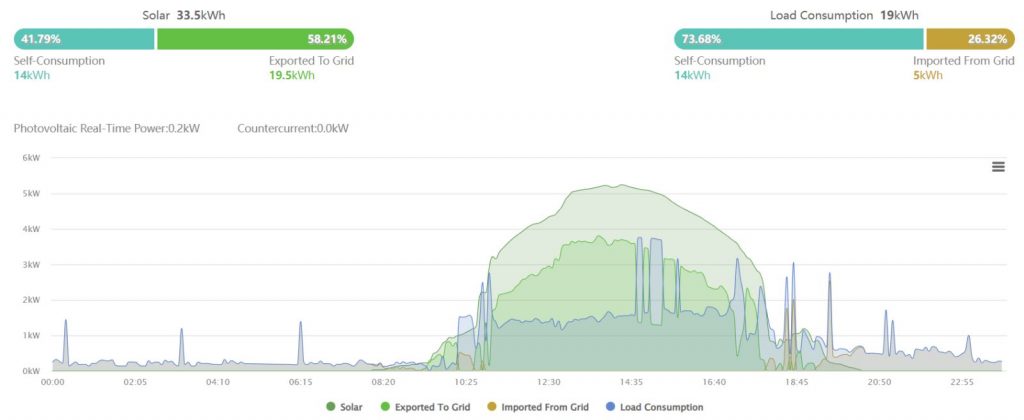
You’re looking at a screenshot from a MiSolar client’s solar app.
The client’s solar panel installation provided 3-5 kW of power between 10am to 5pm on this particular day (tallest green line) and allows them to run their high-efficiency AC units (blue line) at a constant 1-1.5 kW without consuming power from the grid during the day.
You may notice this client consumed 5 kWh electricity from the grid at night (orange line) since this client has no solar battery. But in this case, the nighttime consumption is 100% offset by exporting 19.5 kWh to the grid during the day (dark green line) according to a feed-in tariff. With a virtual battery deal the bill at the end of the month could be as low as €0.
What about a solar powered heat pump?
There is some confusion over the difference between a heat pump and an air-conditioning unit.
A conventional air-conditioning unit only provides cooling – but a heat pump can provide both heating and cooling in the same split-type unit.
It’s confusing because a ‘heat pump’ can heat AND cool.
It gets more confusing because a heat pump is used in high-efficiency solar pool heating. A heat pump is also used in an aerothermal system which can provide hot water to your taps, your shower and even your radiators and central heating system.
Note: you will need different kinds of heat pump depending on whether you are heating or cooling air or heating or cooling water.
But it’s worth considering heat pumps powered by solar panels if you are yet to install any air-conditioning units and want to save as much money as possible on your monthly bills.
That said, heat pumps are typically more expensive that air-conditioning units.
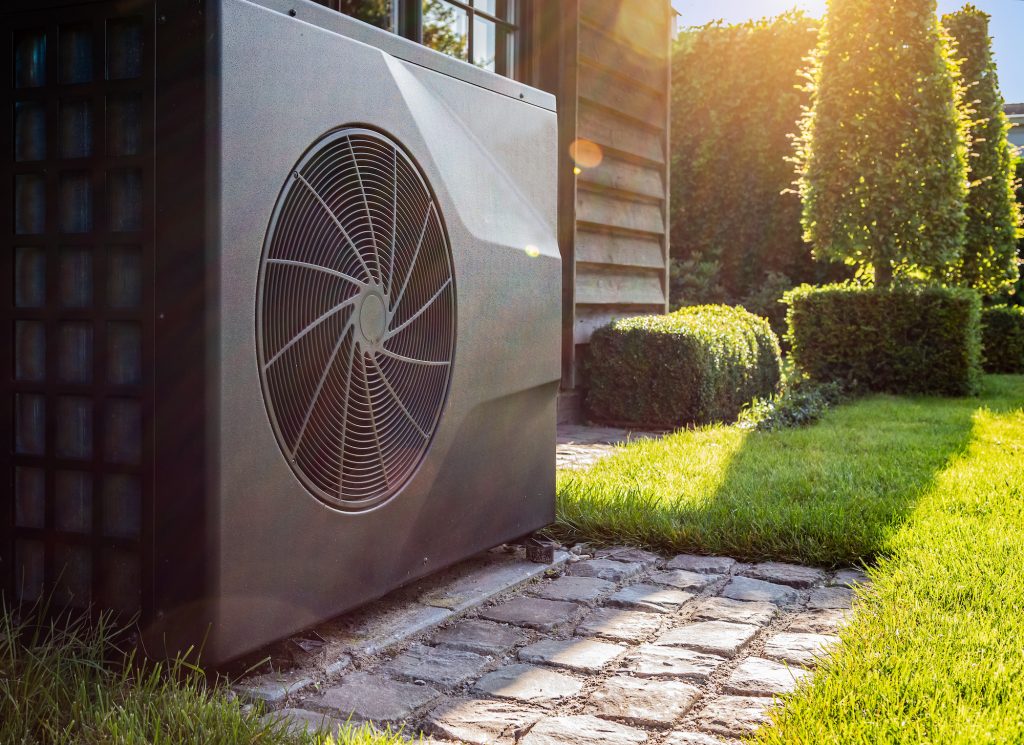
How many solar panels do I need to run my air conditioning units?
It can be as simple as looking at the power input on your air-conditioning unit (usually expressed in W or kW) and then making sure you have enough solar panels to provide sufficient power.
For example, if your AC unit consumes 1.5 kW of power then you need a solar panel installation that can provide at least 1.5 kW of electrical energy.
If you are using solar panels with an output rating of 550W, then you would need at least three.
But the real answer is not so simple.
You need to consider the peak solar hours in your area as well as the orientation of your solar panels towards the sun. For example, solar panels can only provide their maximum power output when they are south-facing and angled at 23-25 degrees against the horizontal.
You must also consider the electricity consumption of other appliances in your home which you may want to run on your own solar energy at the same time as your air-conditioning.
If you have high power appliances you may require a larger solar panel installation to keep your monthly bills as low as possible.
free download
Want to See the Estimated Monthly Cost to Cool Your Home for 8 Hours a Day in Summer?
We’ve prepared a .pdf comparing estimated monthly electricity costs to heat 3 different sized properties using high-efficiency AC units and solar panels.
The three property sizes are:
- Apartment (99m2)
- Average-sized house (144m2)
- Large house (200m2)
We’ve estimated the monthly electricity costs to heat one half of each of these properties using only a solar panel system and no solar battery.
As you’ll see…the difference can be a monthly saving over €500!

